
The Chicago "L" is the rapid transit system serving the city of Chicago and some of its surrounding suburbs in the U.S. state of Illinois. Operated by the Chicago Transit Authority (CTA), it is the fourth-largest rapid transit system in the United States in terms of total route length, at 102.8 miles (165.4 km) long as of 2014, and the third-busiest rapid transit system in the United States. In 2016, the "L" had 1,492 rail cars, eight different routes, and 145 train stations. In 2023, the system had 117,447,000 rides, or about 373,800 per weekday in the fourth quarter of 2023.
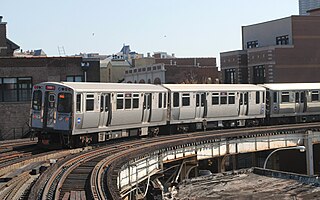
The Red Line is a rapid transit line in Chicago, run by the Chicago Transit Authority (CTA) as part of the Chicago "L" system. It is the busiest line on the "L" system, with an average of 93,457 passengers boarding each weekday in 2022. The route is 26 miles (42 km) long with a total of 33 stations. It runs elevated from the Howard station in the Rogers Park neighborhood on the North Side, through a subway on the Near North Side, Downtown, and the South Loop, and then through the Dan Ryan Expressway median to 95th/Dan Ryan in the Roseland neighborhood on the South Side.
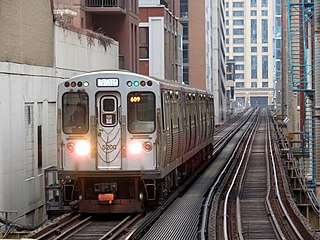
The Green Line is a rapid transit line in Chicago, Illinois, operated by the Chicago Transit Authority (CTA) as part of the Chicago "L" system. It is the only completely elevated route in the "L" system. All other routes may have various combinations of elevated, subway, street level, or freeway median sections.
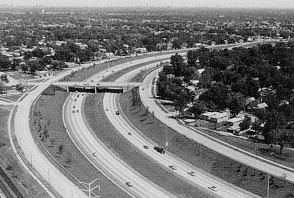
The Dan Ryan Expressway is an expressway in Chicago that runs from the Jane Byrne Interchange with Interstate 290 (I-290) near Downtown Chicago through the South Side of the city. It is designated as both I-90 and I-94 south to 66th Street, a distance of 7.44 miles (11.97 km). South of 66th Street, the expressway meets the Chicago Skyway, which travels southeast; the I-90 designation transfers over to the Skyway, while the Dan Ryan Expressway retains the I-94 designation and continues south for 4.03 miles (6.49 km), ending at an interchange with I-57. This is a total distance of 11.47 miles (18.5 km). The highway was named for Dan Ryan Jr., a former president of the Cook County Board of Commissioners.
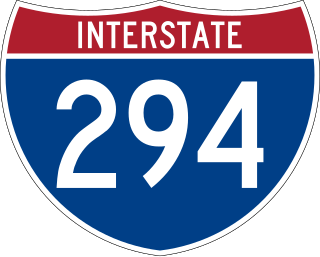
Interstate 294 (I-294) is a tolled auxiliary Interstate Highway in the northeastern part of the U.S. state of Illinois. Forming the southern portion of the Tri-State Tollway in Illinois, I-294 runs from South Holland at I-80/I-94 and Illinois Route 394 (IL 394) to Northbrook at I-94. I-294 is 53.42 miles (85.97 km) long; 5.32 miles (8.56 km) are shared with I-80. It serves as a bypass around the city of Chicago. I-294 is also the longest auxiliary route of I-94, at 10 miles (16 km) longer than I-494 in Minneapolis–Saint Paul. In addition, the tollway is the longest auxiliary Interstate Highway in Illinois, and it intersects the most primary Interstate Highways at six.

Illinois Route 1 (IL 1) is a state highway in the U.S. state of Illinois. Running parallel to the Indiana border, the highway starts at the free ferry crossing to Kentucky at Cave-in-Rock on the Ohio River and runs north to the south side of Chicago as Halsted Street at an intersection with Interstate 57. This is a distance of 325.59 miles (523.99 km).
The Chicago Central Area Transit Plan, generally referred to as the Chicago Central Area Transit Project (CCATP) in the 1970s, was an extensive study of the rapid transit system in downtown Chicago; the study had begun in 1965.

95th/Dan Ryan, announced as 95th, is an 'L' station in the median of the Dan Ryan Expressway and serving Chicago's Roseland neighborhood. It serves as the southern terminus of the Chicago Transit Authority's Red Line. This station was the system's thirteenth busiest in 2021. Trains take approximately 30 minutes to travel to the Loop, and 60 minutes to reach Howard.

Sox–35th is an 'L' station on the CTA's Red Line. It is situated at 142 West 35th Street in the Armour Square neighborhood. The station opened on September 28, 1969, along with the other eight stations on the Dan Ryan branch.
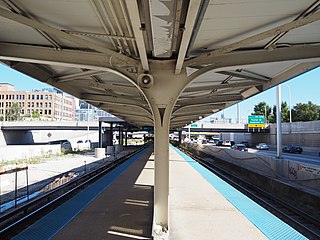
UIC–Halsted, is a Chicago "L" station on the CTA's Blue Line. The station serves the University of Illinois at Chicago, the University Village neighborhood, and the Greektown neighborhood all located in the Near West Side.

Cermak Road, also known as 22nd Street, is a 19-mile, major east–west street on Chicago's near south and west sides and the city's western suburbs. In Chicago's street numbering system, Cermak is 2200 south, or twenty-two blocks south of the baseline of Madison Street. Normally, one mile comprises eight Chicago blocks, but the arterial streets Roosevelt Road, formerly named Twelfth Street and at 1200 South, and Cermak Road were platted before the eight-blocks-per-mile plan was implemented. Roosevelt Road is one mile south of Madison Avenue and there are twelve blocks within that mile. Cermak Road is two miles south of Madison Avenue and there are ten blocks within the mile between Roosevelt and Cermak Roads.

North Avenue is a major east–west street in Chicago, Illinois, and its western suburbs. Starting at St. Charles's eastern border with West Chicago, its name changes from Main Street to North Avenue, just east of the Kane/DuPage county line. From there, it travels straight east, carrying Illinois Route 64 until LaSalle Drive in Chicago. Illinois Route 64 then continues north onto LaSalle Drive for a very short distance until ending at U.S. Route 41, while North Avenue continues east for less than one-half mile, changing its name to North Boulevard at Clark Street, and then continuing until its termination in a cul-de-sac at 200 East, just west of Lake Shore Drive. From Illinois Route 43 to its east end, North Avenue is within the city limits of Chicago.
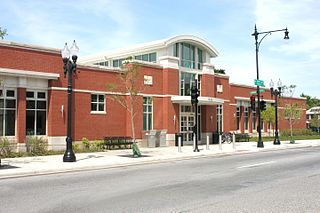
95th Street is a major east–west highway on Chicago's South Side, and in the southwest suburbs, is designated as 9500 South in Chicago's address system. 95th Street is 11 miles (18 km) south of Madison Street.

Wells Street is a major north–south street in Chicago. It is officially designated as 200 West, and is named in honor of William Wells, a United States Army Captain who died in the Battle of Fort Dearborn. Between 1870 and 1912, it was named 5th Avenue so as not to tarnish the name of Wells during a period when the street had a bad reputation.
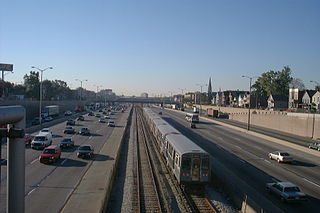
The Dan Ryan branch is a 9.4 mi (15.1 km) long section of the Chicago "L" system located on the South Side of Chicago, Illinois. It is operated by the Chicago Transit Authority, as part of its Red Line service and is normally through-routed downtown towards the North Side via the State Street subway. As of February 2013, the branch serves 45,355 passengers per weekday. As part of the CTA's busiest rapid transit line, it is operated 24 hours a day, 365 days a year. The branch serves the Chinatown, Armour Square, Fuller Park, Englewood, Greater Grand Crossing, Chatham and Roseland neighborhoods.
The Lake–Dan Ryan Line was a rail rapid transit route formerly operated by the Chicago Transit Authority (CTA). The Lake–Dan Ryan Line existed from the opening of the Dan Ryan branch on September 28, 1969, until February 21, 1993. When created, the route united two transit corridors that until 1969 never had through rail service. This routing, which became known as the West-South route, operated from the Harlem terminal in Forest Park on the Lake Street "L" through downtown Chicago along the Union Loop "L", and then via the old South Side "L" and the new Dan Ryan Line to the 95th Street Terminal. The Lake–Dan Ryan service was planned in conjunction with the former Franklin Street Connector and Chicago Central Area Transit Project, both of which were never constructed. The section of the route between the junction with the South Side "L" at 17th and State Streets and the Cermak–Chinatown Station was originally an "interim", or temporary facility. It was planned to be torn down when the Loop Subway system was completed, but survived after the project was canceled in 1979. That section was improved in the 1980s and early 1990s and is currently being used by the Orange Line. Train transfers are possible by using the two unused tracks.

Pershing Road is an east-west street on the south side of Chicago and in its immediate western suburbs in Cook County, Illinois. It is precisely four miles south of Madison Street, the division point between north and south street numbering, and marks the 3900 South point in the region's street numbering system. Its western segment, more commonly referred to as 39th Street, runs east from a U.S. Route 34 in Lyons to Illinois Route 50 in Cicero. Its eastern segment, officially known as Pershing Road, runs east from a cul-de-sac at 3600 West to Oakwood Boulevard, which continues east ending at U.S. Route 41. All of the eastern segment lies within the city of Chicago.

Garfield Boulevard is an east-west street on the south side of Chicago and its immediate western suburbs. Its western segment, entirely known as 55th Street, runs east from Maple Avenue in Downers Grove until it becomes Joliet Road in Countryside. Its eastern segment, known only as Garfield Boulevard from Western Avenue in Gage Park to Elsworth Drive in Washington Park, runs east from Archer Avenue and Narragansett Avenue to South Shore Drive, just west of U.S. Route 41. All of the eastern segment of 55th Street lies within the city limits of Chicago.
Torrence Avenue is a major north–south street in the South Side of Chicago, as well as its southern suburbs. It marks 2628 East in the Chicago address system, being located slightly more than 3+1⁄4 miles (5.2 km) east of State Street. The road runs north from Richton Road in Crete to Steger Road at the Will–Cook county line in Sauk Village. From there, its northern segment begins just west of here. Torrence Avenue continues north, intersecting Interstate 80 (I-80) and I-94 in Lansing. From here, the road goes north until ending just south of 95th Street. The road carries Illinois Route 83 (IL 83) from Glenwood Dyer Road in Lynwood to Sibley Boulevard in Calumet City, as well as carrying US 6 from the Kingery Expressway to 159th Street.
In the spring of 2012, Chicago Transit Authority started a station and track rehabilitation program dubbed "Red Ahead", beginning on the North Side Main Line, which is called the "Red North" project. The program monitors the full route of the Red Line, which does not include the stations of Loyola, Bryn Mawr, Sheridan, or Wilson. Stations between Wilson through Fullerton, and the State Street subway, are also not included. In May 2012, the CTA started to work on the North Side Main Line stations which includes Jarvis, Morse, Granville, Thorndale, Berwyn, Argyle, and Lawrence. The stations are listed in order, starting at Granville, then Morse, Thorndale, Argyle, Berwyn, Lawrence, and finally Jarvis. This project started in June 2012 and completed in December 2012. This project is also part of the Red Ahead's "Red & Purple Modernization" project.
















